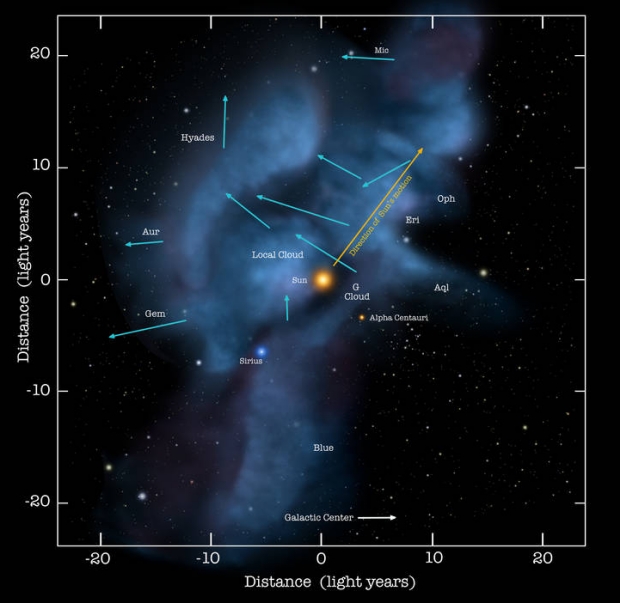We’re living in a prime era for studying the Solar System’s movement through the galaxy, with all that implies about stellar evolution, planet formation and the heliosphere’s interactions with the interstellar medium. We don’t often think about movements at this macro-scale, but bear in mind that the Sun and the planets are now moving through the outer edges of what is known as the local interstellar cloud (LIC), having been within the cloud by some estimates for about 60,000 years.

What happens next? I always think about Poul Anderson’s wonderful Brain Wave when contemplating such matters. In the classic 1954 tale, serialized the year before in Space Science Fiction during the great 1950s boom in science fiction magazines, Brain Wave depicts the Earth’s movement out of an energy-damping field it had moved through since the Cretaceous. When the planet moves out of this field at long last, everyone on the planet gets smarter. What will happen when we leave the LIC?
Nothing this dramatic, as far as anyone can tell, but we’re moving into the so-called G-cloud, a somewhat denser region we’ll get to know within a few thousand years (Alpha Centauri is already within the G-cloud). The LIC appears to be about 30 light years across, sporting somewhat higher density hydrogen than the interstellar medium around it and flowing from the direction of Scorpius and Centaurus. We seem to be moving through its outer edge.
Image: That’s a Richard Powers cover on the first edition of Poul Anderson’s Brain Wave, illustrating a novel Anderson considered one of his best.
The word ‘denser’ has to be kept in perspective. Consider that about half of the interstellar gas – hydrogen and helium for the most part – takes up 98 percent of the space between the stars and is thus extraordinarily low in density, The other half of this gas is compressed into 2% of the volume and is found in molecular clouds, mostly molecular hydrogen, that include some carbon monoxide and higher concentrations of dust than the surrounding ISM.
We’d like to know more about the G-cloud, and in particular such factors as its temperatures and density, for just how the heliosphere reacts to this changing environment, presumably through compression, could have effects upon its shape and thus its shielding effects from cosmic rays. Thus the importance of the Interstellar Probe mission (ISP) out of Johns Hopkins Applied Physics Laboratory that we’ve discussed often in these pages (I’ll point you to Mapping Out Interstellar Clouds for more on the subject). One thing I noted in an article last year was that there are alternative models to the Sun’s nearby cloud environment, some challenging the idea that the LIC and the G-cloud are distinct regions. Interstellar Probe would help in the investigation.

Image: Our solar journey through space is carrying us through a cluster of very-low-density interstellar clouds. Right now the Sun is inside of a cloud (Local cloud) that is so tenuous that the interstellar gas detected by the IBEX (Interstellar Boundary Explorer mission) is as sparse as a handful of air stretched over a column that is hundreds of light-years long. These clouds are identified by their motions, indicated in this graphic with blue arrows. Credit: NASA/Goddard/Adler/U. Chicago/Wesleyan.
The fate of Interstellar Probe is the hands of the National Academies of Sciences, Engineering, and Medicine, which prioritizes in its decadal studies where we are going in space exploration over ten year periods. We find out next year whether ISP has been selected among several strong candidates for the Decadal Survey for Solar and Space Physics (Heliophysics) 2024-2033. Until then, I continue to scout the literature both for Interstellar Probe as well as JPL’s Solar Gravitational Lens (SGL) mission, a candidate for the same study. These are huge decisions in space science.
Be aware of a new paper tackling the issues of heliospheric and dust science that a mission like Interstellar Probe could examine, with a solid backgrounder on the kind of instrumentation that would make this first dedicated interstellar probe a game-changer in our understanding of the local interstellar environment. The paper, by lead author Veerle J. Sterken (ETH Zürich) and colleagues, was originally submitted to the heliophysics Decadal, and is here available in a modified version (citation below) that includes the new instrumentation discussion among other modifications.
I won’t run through the entire paper; suffice it to say that its discussion of interstellar dust in and around the heliosphere is comprehensive and its analysis of how best to study changing environments in the interstellar medium is highly informative. The benefit of a probe explicitly designed to examine the transition between dust and gas states along its trajectory are clear. From the paper, which notes here the particular importance of heliopause passage:
ISP will fly throughout approximately 16 years, more than a solar cycle, while passing through interplanetary space, the termination shock, the heliosheath, up to the heliopause and beyond, making it an optimal mission for studying the heliosphere-dust coupling and using this knowledge for other astrospheres. Beyond the heliopause, the tiny dust with gyro-radii of only a few to 100 AU (for dust radii < 0.1 μm…), will help study the interstellar environment (magnetic field, plasma) and may detect local enhancements of smaller as well as bigger ISD [interstellar dust]. The strength of the mission lies in flying through all of these diverse regions with simultaneous magnetic field, dust, plasma and pickup ion measurements. No mission so far has flown a dedicated dust dynamics and composition suite into the heliosheath and the vast space beyond.
Analyzing the interaction between the heliosphere and interstellar dust acts as a probe into the history of our own Solar System, since we know that some of this material was affected by near-Earth supernovae, still raining down in the form of dust today. Mid-sized dust particles in the range of 0.1 to 0.6 μm in radius can make it through the heliosphere into the Solar System. Some smaller particles (30-100 nm) as well may escape filtering, but the authors note the limitations of our knowledge: “The exact lower cut-off size and time-dependence of particles that can enter the solar system is not yet exactly known, but Ulysses and Cassini already have measured ISD particles with radii between 50 and 100 nm.”
Thus we have markers for stellar and galactic evolution as factors in this study. But I’ll also remind those interested in interstellar flight that assessing dust density and the size distribution of particles will play a major role when we reach the point where we can send craft at a significant fraction of the speed of light. Larger particles in the local interstellar environment could cause catastrophic failure, while Ian Crawford has pointed out that other properties of this region could inform propulsion concepts like the interstellar ramjet.
Something else I learned from Ian Crawford (University of London) and wrote about twelve years ago (see Into the Interstellar Void) is that a spacecraft moving at 0.1c could make daily measurements 17 AU apart, which is roughly half the radius of the Solar System. So as we develop the fastest probe we can manage today in the form of designs like Interstellar Probe, we can see a larger picture in which such studies assist as we develop future technologies capable of actually making a crossing to Alpha Centauri, sampling widely along the way two different interstellar clouds and the boundary between them.
The paper is Sterken et al., “Synergies between interstellar dust and heliospheric science with an Interstellar Probe,” submitted as white paper for the National Academies Decadal Survey for Solar and Space Physics 2024-2033 and available as a preprint here.



Understood from the above introduction and the pre-print that the proposed mission target is micron sized material in the nearby interstellar medium.
And a lot of that determination could be done by contact with on-board sensors.
Still, there is an opportunity to get a little closer to Oort Cloud. Beaming back perhaps from its assumed interior. While we see comets with origins from rather deep space ( e.g., with eccentricities – / + 1.000 with very narrow margins, orbital elements of that nature could drop in from anywhere due to some sort of perturbing event. The Kuiper Belt is a conservative solution because it’s closer – and we can see some substantial objects out there rivaling Pluto in dimensions.
But we haven’t had much success positively identifying anything of magnitude in the Oort Cloud. Intrinsically dim and if the objects are as small as a turned off comet, hard to resolve.
It would be nice to get something working on that problem. Whether it is a spacecraft on its way out to there or something closer to home. But if it were a spacecraft, I would imagine it something like sonar emitting an omni directional beep and receptive to the return ping.
Otherwise, waiting to cross galactic cloud lines: “Congratulations. Now you can start and operate Bussard nuclear fusion jets fed by the medium….”
Maybe? Hope by then we have a better alternative.
The way Science depicted it in 2010, the Sun lay directly aligned with the cornea of an immense eye (the IBEX ribbon: https://www.science.org/content/article/sun-may-soon-plunge-hot-cloud-interstellar-gas ) into which it might plunge within 100 years or so. This was of interest because around the edge of this cornea there was, in lieu of a ciliary body, a supernova, or at least, enough leftover particles from one to endanger astronauts and space colonists.
Looking through the citations at Arxiv ( https://arxiv.org/abs/1004.3917 ) I see a 2016 parallax measurement that places the IBEX ribbon about 140 AU away, “just outside the heliopause”. I think the scenario above has been largely ruled out: https://iopscience.iop.org/article/10.3847/1538-4357/acc577/pdf That also puts this feature in range for some of these probes to study at any time.
While Anderson’s “Brain Wave” posits that a local cloud density affects neural efficiency, Vernor Vinge ups the ante to the galaxy scale with his Zones of Thought in his novel “A Fire Upon the Deep”. There are 3 zones, with Earth in the middle zone – the Slow Zone. The lowest level is The unthinking Depths surrounding the galactic center.
– Wikipedia. So there seems to be a correspondence between ISM density and the impact on thinking capabilities. Conversely, higher cloud densities seem to be associated with intelligent entities, such as Hoyle’s “The Black Cloud” and Clarke’s plasma beings in the sun (“Out of the Sun”).
To me, these ideas all seem more fantasy than SF, let alone hard SF.
Great novel, though. I loved A Fire Upon the Deep.
Are you aware that Brad deLong (prof. Economics at Berkeley) and Noah Smith, have a podcast series called Hexapodia, named after a idea in A Fire Upon the Deep.
The idea, from the book is:
If the image of the clouds is in any way correct, I like the idea that there is a narrow path of low-density ISM that could be navigated by high-relativistic ships to minimize any potential hull damage from gas and dust, therefore reducing the shielding needed (whether mass like the ice shield of the Magellan in Clarke’s The Songs of Distant Earth, or energy). We don’t usually think of such old, sea-analog, navigation maps for space, but perhaps if spaceships ever get to travel at such speeds, this sort of map might return, connecting star travel to ocean travel. I think Jean-Luc Picard would approve.